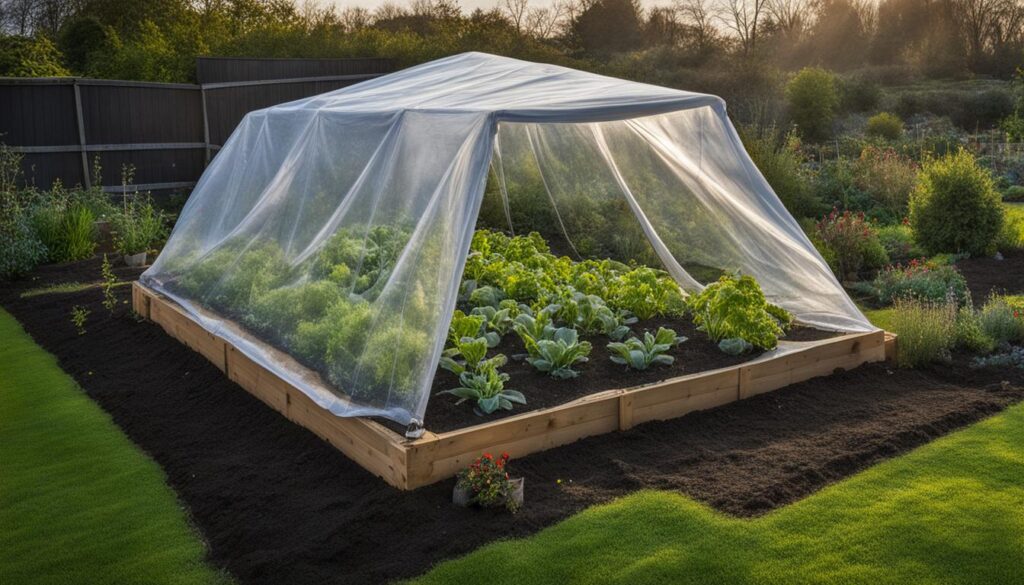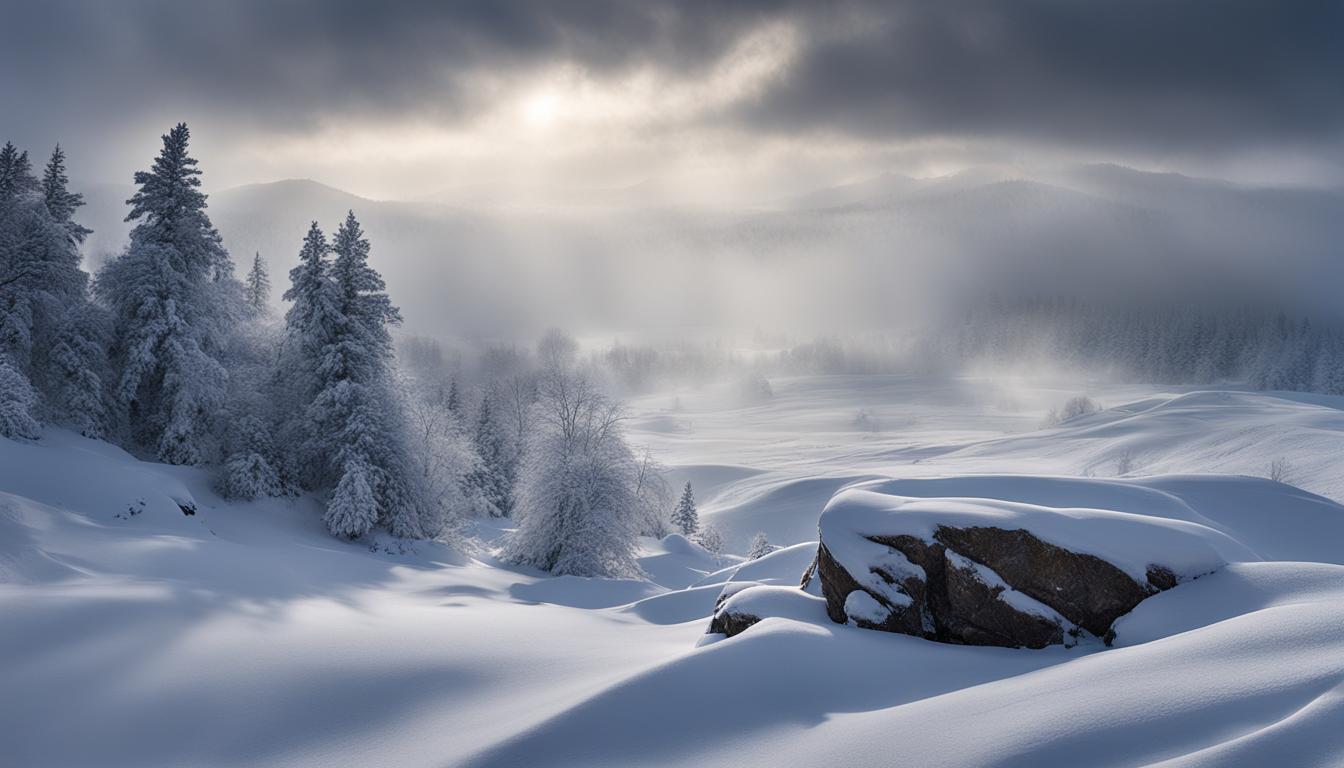Frost and freeze warnings are issued by the National Weather Service to alert the public about potential cold weather conditions that can harm plants. While both warnings indicate low temperatures, they have different thresholds and implications for plant damage. A frost occurs when the temperature drops below 36 degrees Fahrenheit, with widespread frost formation below 32 degrees. On the other hand, a freeze warning is issued when significant, widespread freezing temperatures are expected. Understanding these distinctions is crucial for taking appropriate measures to protect plants.
Key Takeaways:
- Frost and freeze warnings are issued by the National Weather Service to alert about potential cold weather conditions that can harm plants.
- A frost occurs when the temperature drops below 36 degrees Fahrenheit, with widespread frost formation below 32 degrees.
- A freeze warning indicates significant, widespread freezing temperatures.
- Understanding the difference between frost and freeze warnings is crucial for taking appropriate measures to protect plants.
- Proper plant protection measures can help mitigate the impact of frost and freeze events.
National Weather Service Terms for Frost and Freeze Warnings
The National Weather Service plays a crucial role in providing information and warnings related to frost and freeze conditions. Understanding the terms used by the National Weather Service can help individuals better prepare for and respond to these weather events. Here are some key terms to be aware of:
Frost Advisory
A frost advisory is issued when the minimum temperature is forecasted to be between 33 and 36 degrees Fahrenheit on clear and calm nights. This advisory indicates the potential for frost formation, which can be harmful to plants, particularly sensitive ones.
Freeze Watch
A freeze watch is issued when significant freezing temperatures are expected within the next 24 to 36 hours. It serves as an early warning for potentially damaging freeze conditions and allows individuals to take necessary precautions to protect their plants.
Freeze Warning
A freeze warning is the most severe type of warning issued by the National Weather Service. It indicates that significant, widespread freezing temperatures are expected. This warning alerts individuals to take immediate action to protect sensitive plants from the potentially devastating effects of prolonged freezing temperatures.
https://www.youtube.com/watch?v=71pJpxZUkU0
| Warning Level | Temperature Range | Weather Conditions | Implications for Plants |
|---|---|---|---|
| Frost Advisory | 33-36 degrees Fahrenheit | Clear and calm nights | Potential frost formation, risk of harm to sensitive plants |
| Freeze Watch | Significant freezing temperatures within 24-36 hours | Imminent threat of freezing weather | Risk of damage to plants if protective measures are not taken |
| Freeze Warning | Significant, widespread freezing temperatures | Prolonged freezing conditions | Potential devastation to sensitive plants if not adequately protected |
These terms are used to communicate the severity and urgency of the cold weather conditions. It is important to stay updated with the latest information from the National Weather Service and to take appropriate measures to protect plants when frost or freeze warnings are issued.
How Frost and Freeze Affect Plants
To understand how frost and freeze conditions can affect plants, it is important to recognize the differences in their impact. Frost occurs when temperatures drop below 36 degrees Fahrenheit, resulting in the formation of ice crystals on the surface of plants. This can lead to wilting, blackening, and spotting of foliage, causing damage to delicate plants. On the other hand, a freeze is a more prolonged event where the interior temperature of the plant reaches 32 degrees Fahrenheit, causing the cells to release water and break down. This can result in the development of brown or black spots, mushy areas, and even the death of annual plants.
To better visualize the effects of frost and freeze on plants, let’s take a closer look at the differences:
| Frost | Freeze | |
|---|---|---|
| Temperature | Below 36°F | 32°F |
| Damage | Wilting, blackening, spotting of foliage | Brown/black spots, mushy areas, death of annual plants |
As indicated by the table, frost and freeze conditions have distinct temperature thresholds and consequences for plant health. Understanding these differences is vital for implementing effective protection measures to safeguard plants.
Protecting Plants from Frost and Freeze Damage
Protecting plants from frost and freeze damage is crucial to ensure their health and survival during cold weather conditions. By taking proactive measures, gardeners can minimize the risk of damage and preserve the beauty of their plants. Here are some effective strategies and precautions to protect plants from frost and freeze:
1. Covering Plants
When a frost or freeze is expected, covering plants with an old sheet or a light cover can provide much-needed protection. This barrier helps to trap heat close to the plant and prevent frost or freeze damage. It is important to ensure that the cover extends all the way to the ground and is securely fastened to prevent cold air from seeping in. Additionally, removing the cover in the morning allows the plants to benefit from the warming sunlight.
2. Bringing Potted Plants Indoors
Potted plants are more susceptible to frost and freeze damage due to their limited insulation. To protect them, it is advisable to bring them indoors during cold weather conditions. Place them in a location with sufficient light and moderate temperature. If moving them indoors is not feasible, grouping them together and covering them with a blanket or burlap can provide some level of protection.
3. Watering the Ground
Watering the ground around freeze-prone plants before a frost can help increase the amount of heat held by the soil. Moist soil retains heat better than dry soil, providing a safety zone for the plants’ roots. However, it is important to avoid overwatering, as excessive moisture can lead to other issues such as root rot. The goal is to provide enough moisture to insulate the roots without saturating the soil.
Implementing these frost prevention tips and freeze precautions can significantly reduce the risk of damage to plants. By being proactive and attentive to the weather conditions, gardeners can protect their plants and ensure their continued vitality.

Frost vs Freeze Warning: Duration and Severity
When it comes to frost and freeze warnings, one important factor to consider is the duration and severity of the cold weather conditions. Understanding these differences can help individuals take appropriate measures to protect their plants. A frost warning typically lasts for a shorter period, ranging from minutes to hours. However, it may not be as severe as a freeze warning. On the other hand, a freeze warning indicates a more significant threat of freezing temperatures and typically lasts throughout the night.
To further illustrate the variation between frost and freeze warnings, let’s take a look at the duration and severity in a table:
| Warning Type | Duration | Severity |
|---|---|---|
| Frost Warning | Shorter period (minutes to hours) | Less severe |
| Freeze Warning | Throughout the night | More severe |
By understanding the duration and severity of frost and freeze warnings, individuals can determine the level of protection needed for their plants. The severity and duration of cold weather conditions play a significant role in the potential damage that may occur. It is important to stay informed about the latest weather updates and take appropriate actions to safeguard plants accordingly.
Protecting Plants During Frost: Techniques and Tips
When facing a frost, there are several techniques and tips that can help protect plants. It is important to take proactive measures to safeguard plants from the damaging effects of cold weather. Here are some effective strategies:
- Watering the ground: Before a frost event, watering the ground around freeze-prone plants can increase the amount of heat held by the soil. This helps create a safety zone and provides some insulation for the plants.
- Using woven cloth covers: Instead of using paper or plastic covers, which can trap moisture and lead to further damage, opt for woven cloth covers. These covers provide better insulation and allow for proper airflow.
- Removing covers in the morning: It is crucial to remove the covers before sunrise to prevent overheating of the plants. Leaving the covers on for too long can trap heat and moisture, increasing the risk of fungal diseases.
- Planting hardy varieties: Pay attention to frost dates and avoid planting tender plants before the frost-free date. Choosing plants that are hardy to the local hardiness zone can help them withstand frosts better.
Implementing these protective measures can help safeguard plants during frost events and minimize the risk of damage. It is essential to stay informed about weather predictions and take appropriate actions to protect plants from the potential harm caused by frost.
Table: Recommended Techniques for Protecting Plants During Frost
| Technique | Description |
|---|---|
| Watering the ground | Increases heat retention in the soil, providing a safety zone for plants |
| Using woven cloth covers | Provides insulation and allows for proper airflow |
| Removing covers in the morning | Prevents overheating and reduces the risk of fungal diseases |
| Planting hardy varieties | Choosing plants that can withstand frosts better |
By following these techniques and taking the necessary precautions, gardeners can protect their plants from the detrimental effects of frost. It is important to tailor the protection measures to suit the specific needs of the plants and the severity of the frost conditions. With proper care and attention, plants can thrive even in challenging weather conditions.
Protecting Plants during Freeze: Strategies and Precautions
When faced with freezing temperatures, it’s crucial to take additional strategies and precautions to protect your plants. Here are some effective measures to safeguard your plants during a freeze:
Move sensitive plants indoors:
One of the most effective methods to protect plants from freezing temperatures is to bring them indoors. This can be done by transferring potted plants into a sheltered area, such as a garage or greenhouse. By providing a warmer environment, you can prevent the detrimental effects of a freeze on your plants.
Mulch around plants:
Applying a layer of mulch around your plants can provide insulation and help retain heat in the soil. Mulching helps to protect the root zones of plants, keeping them warm and reducing the risk of frost damage. Organic materials such as straw, wood chips, or shredded leaves are great options for mulching.
Lift and store tender bulbs:
If you have tender bulbs in your garden, it’s important to dig them up before freezing weather arrives. Gently lift the bulbs from the ground and store them in a cool, dry place until the freeze has passed. This will ensure their survival and allow you to replant them when the weather conditions improve.
Use sprinklers or create a protective glaze:
In orchards or large plantings, sprinklers can be used to create a protective glaze of ice over plants. This ice layer acts as insulation and prevents radiation, keeping the interior temperatures slightly warmer. However, it’s essential to start the sprinklers before temperatures drop below freezing and to keep the water running until the freeze has ended.
Overall, these strategies and precautions can help minimize the damage caused by freezing temperatures. By being proactive and implementing these measures, you can protect your plants and increase their chances of survival during a freeze.

Conclusion
The difference between frost and freeze warnings lies in their thresholds and implications for plant health. Frost occurs when the temperature drops below 36 degrees Fahrenheit, with widespread frost formation below 32 degrees. On the other hand, a freeze warning indicates significant, widespread freezing temperatures. Understanding these distinctions is crucial for taking appropriate measures to protect plants.
The National Weather Service issues various advisories, watches, and warnings related to frost and freeze conditions. A frost advisory is issued when the minimum temperature is forecasted to be between 33 and 36 degrees Fahrenheit. A freeze watch indicates the expectation of significant freezing temperatures within the next 24 to 36 hours. A freeze warning, on the other hand, indicates significant, widespread freezing temperatures. These terms help communicate the severity of the cold weather conditions and allow individuals to prepare accordingly.
Both frost and freeze conditions can cause damage to plants. Frost leads to the formation of ice crystals on plant surfaces, resulting in wilting, blackening, and spotting of foliage. A freeze, on the other hand, causes the interior temperature of the plant to reach 32 degrees Fahrenheit, leading to the release of water and cell breakdown. To protect plants from frost and freeze damage, various measures can be taken, such as covering plants, bringing potted plants indoors, and watering the ground to increase soil heat retention.
By understanding the duration and severity of frost and freeze warnings, individuals can determine the appropriate actions to protect plants and mitigate potential damage. Techniques and tips specific to frost events include watering the ground, using woven cloth covers, and avoiding planting tender plants before the frost-free date. For freeze events, additional strategies such as moving sensitive plants indoors, mulching around plants, and using sprinklers or lights can be employed to minimize damage. By being prepared and proactive, gardeners can safeguard their plants and minimize the risk of damage during cold weather.
FAQ
What is the difference between a frost warning and a freeze warning?
A frost warning is issued when the temperature drops below 36 degrees Fahrenheit, with widespread frost formation below 32 degrees. A freeze warning, on the other hand, indicates that significant, widespread freezing temperatures are expected.
How do frost and freeze conditions affect plants?
Frost can result in the formation of ice crystals on the exterior surface of plants, leading to wilting, blackening, and spotting of foliage. A freeze causes the temperature inside the plant to reach 32 degrees Fahrenheit, resulting in the release of water and cell breakdown, which can lead to brown or black spots, mushy areas, and even death of annual plants.
What can I do to protect my plants from frost and freeze damage?
There are several methods you can employ, such as covering plants with a sheet or light cover, bringing potted plants indoors, watering the ground around freeze-prone plants, paying attention to frost dates and planting hardy plants.
How long do frost and freeze warnings typically last?
A frost warning typically lasts for a shorter period, ranging from minutes to hours. A freeze warning lasts throughout the night.
What techniques can I use to protect plants during a frost?
Techniques such as watering the ground around freeze-prone plants, using woven cloth covers for insulation, removing covers before sunrise, paying attention to frost dates, and choosing hardy plants can help protect plants during a frost.
What precautions should I take to protect plants during a freeze?
Precautions like moving sensitive plants indoors, mulching around plants to insulate root zones, lifting and storing tender bulbs, using sprinklers to create a glaze of ice, using string or utility lights in unheated greenhouses or under row covers can help protect plants during a freeze.
 Skip to main content
Skip to main content


